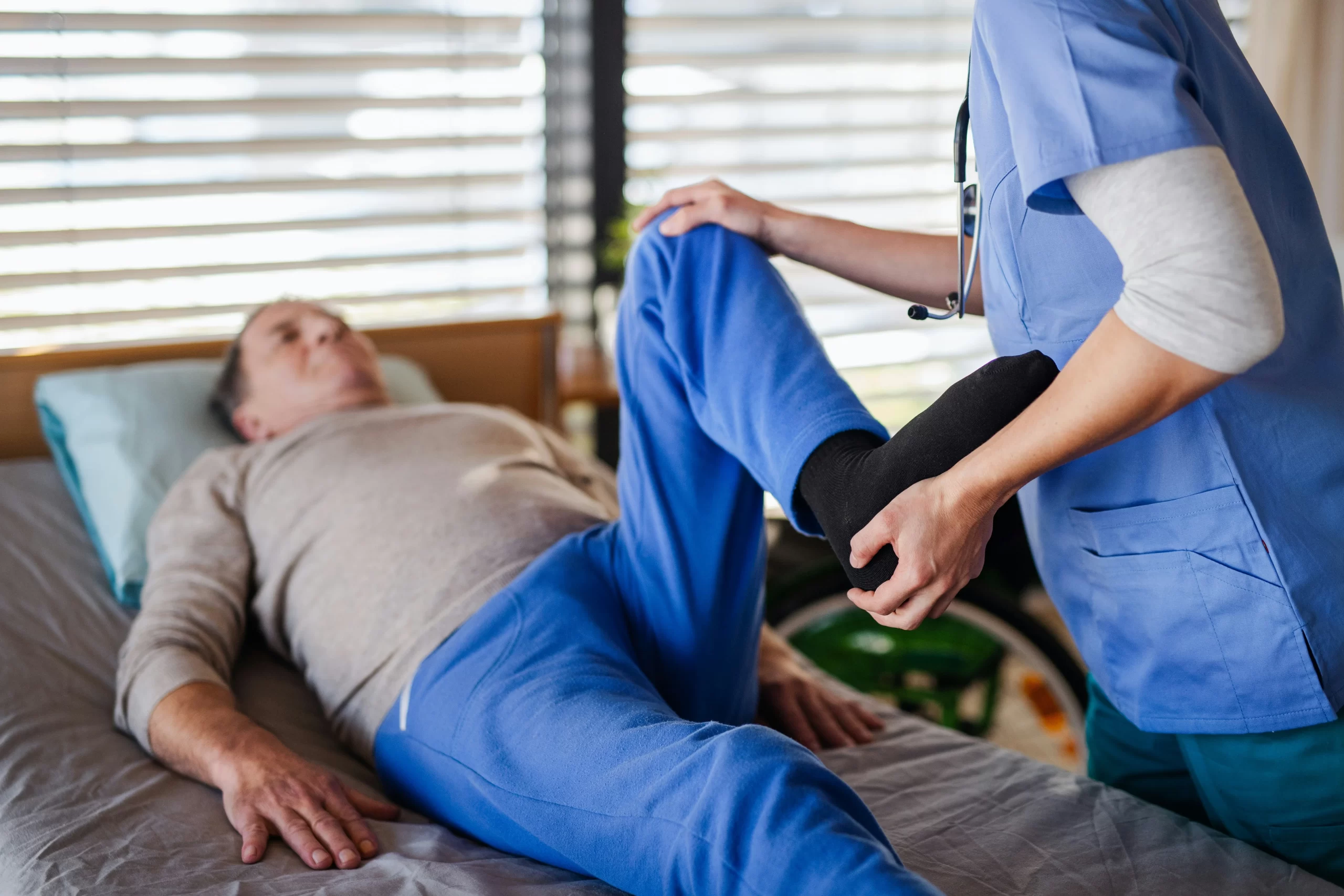Imagine finding lasting pain relief without pills, injections, or surgery. Anodyne therapy makes this possible, bringing professional-grade healing technology directly to your home.
This innovative treatment uses targeted infrared light to address pain at its source, offering hope for those seeking effective alternatives to traditional pain management approaches.
Whether you’re dealing with diabetic neuropathy, arthritis, or recovery challenges, understanding how anodyne therapy at home works empowers you to take control of your comfort and healing journey.
Related: Nursing Care Plan for Chronic Obstructive Pulmonary Disease: A Practical Starter Guide
What Is Anodyne Therapy and How Does It Work
Anodyne therapy represents breakthrough pain management technology that harnesses the natural healing power of infrared light. This FDA-cleared treatment delivers specific wavelengths of light energy to targeted areas of your body, promoting natural healing processes without medications or invasive procedures.
Understanding Infrared Light Technology
Infrared therapy for pain operates using wavelengths between 660 and 890 nanometers, which penetrate deep into tissue layers. These specific light frequencies stimulate cellular activity at the mitochondrial level, where your body’s energy production occurs.
Unlike visible light, infrared wavelengths reach muscles, joints, and other structures beneath the skin’s surface. The therapeutic light energy triggers biochemical reactions that enhance cellular repair mechanisms and promote faster tissue regeneration.
The Science Behind Pain Relief
When infrared light penetrates your tissues, it increases nitric oxide production within blood vessels, causing them to dilate and improve circulation. Enhanced blood flow delivers more oxygen and nutrients to damaged or inflamed tissues while removing metabolic waste products that contribute to discomfort.
The therapy also stimulates the release of endorphins, your body’s natural pain-relieving chemicals. Additionally, anodyne therapy helps reduce nerve sensitivity by modulating pain signals sent to your brain, providing both immediate comfort and long-term healing benefits.
How Anodyne Devices Deliver Treatment
Professional-grade anodyne devices consist of flexible pads containing multiple infrared light-emitting diodes (LEDs) that conform to your body’s contours. These pads connect to a control unit that regulates treatment intensity and duration based on your specific needs.
The device delivers consistent, calibrated light energy across the treatment area, ensuring uniform therapeutic coverage. Most sessions last between 20 and 30 minutes, during which the infrared light works continuously to promote healing and comfort.
Why Anodyne Therapy Benefits Pain Management

The therapeutic advantages of anodyne therapy benefits extend far beyond simple pain relief, offering comprehensive improvements that address multiple aspects of chronic conditions.
This treatment approach provides measurable enhancements in circulation, inflammation reduction, and overall quality of life without the side effects associated with pharmaceutical interventions.
Improved Blood Circulation and Healing
Anodyne therapy significantly enhances microcirculation by dilating blood vessels and improving blood flow to treated areas. This increased circulation delivers essential nutrients and oxygen to damaged tissues while facilitating the removal of inflammatory substances and metabolic waste. Better blood flow accelerates the natural healing process, helping tissues repair themselves more efficiently.
Patients often notice improved skin color and temperature in treated areas, indicating restored circulation that supports long-term healing and comfort.
Reduced Inflammation and Swelling
The infrared light energy from anodyne therapy helps modulate inflammatory responses by reducing pro-inflammatory cytokines while promoting anti-inflammatory mediators. This biological response leads to decreased swelling and tissue irritation that often contribute to chronic conditions.
The therapy’s anti-inflammatory effects are particularly beneficial for conditions like arthritis, where joint inflammation causes significant discomfort. Regular treatment sessions help maintain reduced inflammation levels, preventing flare-ups and improving overall joint function.
Non-Invasive Alternative to Medications
Unlike pharmaceutical approaches, anodyne therapy provides relief without systemic side effects or drug interactions. This makes it an ideal option for patients who cannot tolerate certain medications or prefer to minimize their pharmaceutical dependence.
The treatment requires no recovery time, allowing you to resume normal activities immediately after each session. Many patients successfully reduce their reliance on pain medications while maintaining effective symptom management through consistent anodyne therapy treatments.
What Conditions Anodyne Therapy Treats Most Effectively
Anodyne therapy for neuropathy and other conditions demonstrates particular effectiveness in treating issues involving poor circulation, nerve dysfunction, and inflammatory processes.
Clinical experience has identified specific conditions that respond exceptionally well to this infrared light treatment.
Diabetic Neuropathy and Nerve Pain
Anodyne therapy has shown remarkable success in treating diabetic peripheral neuropathy, a common complication affecting many diabetes patients. The therapy helps restore sensation in affected extremities while reducing the burning, tingling, and shooting pains characteristic of nerve damage.
Improved circulation from the treatment helps deliver nutrients to damaged nerve tissues, potentially supporting neuropathy management. Many patients experience reduced numbness and improved balance, which can help prevent falls and other complications associated with diabetic neuropathy.
Arthritis and Joint Stiffness
Patients with osteoarthritis and rheumatoid arthritis often find significant relief through regular anodyne therapy sessions. The treatment reduces joint inflammation and stiffness while improving range of motion and functional mobility.
The deep-penetrating infrared light reaches joint capsules and surrounding tissues, promoting healing in cartilage and reducing discomfort-causing inflammation.
Post-Surgical Recovery and Wound Healing
Anodyne therapy accelerates post-operative healing by enhancing cellular regeneration and reducing inflammatory responses at surgical sites. The improved circulation helps deliver healing nutrients while removing cellular debris that can slow recovery.
Patients often experience reduced post-surgical discomfort and swelling when anodyne therapy is incorporated into their recovery protocol. The treatment also helps minimize scar tissue formation and improves overall tissue quality during the healing process.
How to Set Up Your Home Infrared Therapy Device

Proper setup of your home infrared therapy device ensures safe, effective treatment while maximizing therapeutic benefits. Taking time to create an optimal treatment environment and following proper positioning guidelines will enhance your anodyne therapy experience and outcomes.
Choosing the Right Treatment Location
Select a quiet, comfortable space where you can relax during your sessions without interruption. The treatment area should have adequate electrical outlets and comfortable seating or lying positions that allow easy access to the areas requiring treatment.
Ensure the space has good ventilation and maintains a comfortable temperature, as some patients may feel warm during infrared light therapy. You also might want to consider using a reclining chair or bed that supports proper positioning for extended treatment periods while keeping you comfortable and relaxed.
Proper Positioning and Distance Guidelines
Position the anodyne therapy pads directly on or very close to the skin over the affected area, ensuring complete contact for optimal light penetration. The device should maintain consistent contact throughout the entire treatment session to ensure uniform light delivery.
Secure the pads properly to prevent movement during treatment, which could reduce therapeutic effectiveness or create uneven light distribution.
Safety Precautions and Equipment Care
Always inspect your anodyne therapy device before each use, checking for damaged cords, cracked pads, or other signs of wear that could compromise safety. Clean the device according to manufacturer instructions, typically using gentle disinfectants that won’t damage the LED components. Store the equipment in a dry, temperature-controlled environment to protect sensitive electronic components.
Never use the device on broken skin, and always follow the recommended treatment duration to prevent overexposure to infrared light energy.
What to Expect During Your First Anodyne Therapy Sessions
Beginning anodyne therapy treatment guide protocols involves understanding normal sensations, realistic timelines for improvement, and recognizing signs that indicate your therapy is working effectively.
Initial Sensations and Treatment Duration
During your first anodyne therapy session, you may feel a gentle warming sensation as the infrared light penetrates your tissues. This warmth is normal and indicates that the therapy is working to improve circulation in the treated area.
Some patients feel relaxed and may even fall asleep during treatment, while others notice an immediate sense of improved comfort. Each session typically lasts 20 to 30 minutes, providing sufficient time for the therapeutic light to stimulate healing processes without overexposure.
Gradual Improvement Timeline
Most patients begin noticing subtle improvements within the first few treatment sessions, though significant results typically develop over several weeks of consistent use. Comfort improvement often occurs gradually, with many patients reporting decreased discomfort intensity and improved mobility after two to four weeks of regular protocols.
The healing process varies based on individual conditions, severity of symptoms, and overall health status. Consistency in treatment scheduling plays a crucial role in achieving optimal results, with most protocols recommending daily or every-other-day sessions.
Signs Your Treatment Is Working
Positive indicators that your anodyne therapy is effective include reduced discomfort intensity, improved sleep quality, and enhanced ability to perform daily activities.
Many patients notice improved circulation evidenced by better skin color, reduced swelling, and increased warmth in previously cold extremities. Enhanced sensation and reduced numbness are common improvements, particularly for patients with neuropathy conditions.
Decreased reliance on medications and improved overall quality of life serve as additional markers of successful anodyne therapy outcomes.
Get Professional Anodyne Therapy Support with Icon Home Health
Ready to experience relief in the comfort of your home? Icon Home Health’s skilled physical therapists can guide you through proper anodyne therapy techniques, ensuring safe and effective treatment tailored to your specific needs. Our Medicare-certified team brings professional expertise directly to your doorstep, helping you achieve optimal comfort and improved quality of life.
Don’t let chronic discomfort control your life. Contact our home health care services in Houston, Texas team today to learn how professional anodyne therapy support can help you regain comfort and mobility. Healthcare providers can easily refer a patient to access our specialized services, or visit us at our Houston location to discuss how we can support your patients’ wellness goals.